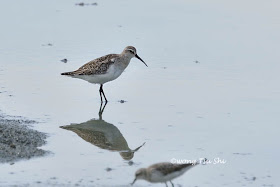There are two races occurring in Borneo, one race being scarce non-breeding winter visitor from mainland Asia H. c. major and the resident race H. c. minor.
H. c. major is a slightly larger bird at 25 to 27 cm compared to 23 cm of H. c. minor, however, since this species always occur singly, ascertaining the race by size alone base on a solitary bird in the field can be deceptive.
During the duration of the just concluded Borneo Bird Festival in October at Rain Forest Discovery Centre in Sepilok, Sandakan, one bird was seen every day feeding at a small pond next to the Woodpecker Avenue. It was the star bird of the Festival, keeping both the bird watchers and bird photographers waiting by the pond to take a good look/image of it.
1. Rich purple wash on the upper parts compare to orange or ruddy-brown for H. c. major,
2. Rufous chin/throat compare to almost white chin/throat of H. c. major, and
3. Purple tinged breast which is absent on H. c. major.
Happy birding.


























